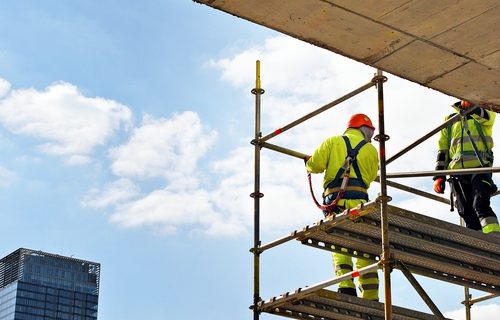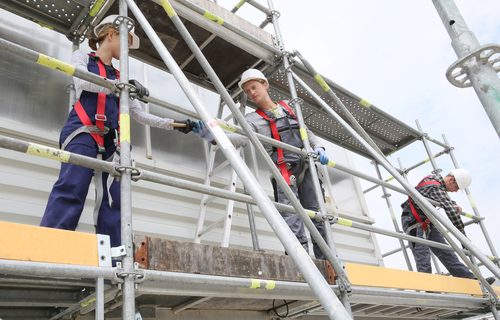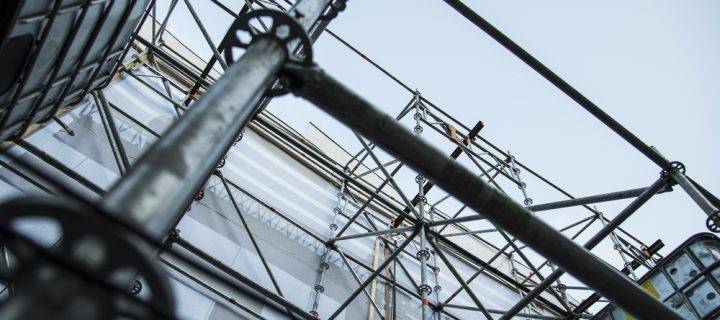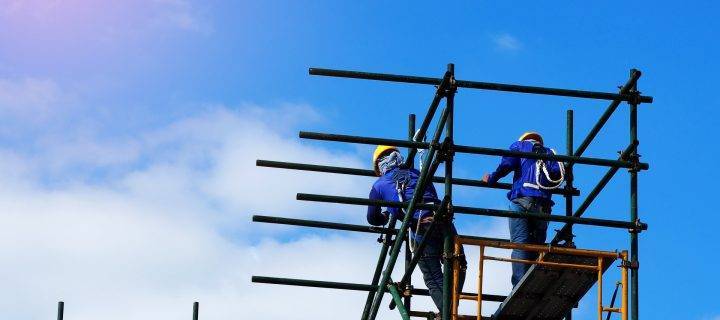2021 has already brought with it a whole range of unsavoury weather conditions! But what does this mean for working with scaffolding? The risks of working at a height in bad weather should not be understated, and working in improper weather conditions can be extremely hazardous. However, there are ways that you can ensure that your employees stay safe during periods of bad weather. Introduce extra safety checks for scaffolding As a requirement of the Working at Height Regulations 2005, scaffolding should be checked after every incident of bad weather. It’s important to ensure that planks are not slippery, particularly after rain or snow, or if there has been a risk of ice. Take precautions If you know you will be using scaffolding during a predicted period of bad weather, it’s worth considering this in advance. That way you can take extra precautions and steps to weatherproof your scaffolding as much as possible. For example, temporary roofs can assist in protecting scaffolding from extreme weather conditions. In addition, ensuring that workers wear harnesses and any other safety equipment and footwear, is of the utmost importance, particularly during inclement weather. So it’s important to ensure that your site is fully supplied with this equipment and that you implement checks to ensure your staff are following proper procedures. Prioritise the safety of your staff When your employees are working in difficult weather conditions, it’s extremely important to prioritise their safety. It’s important to stay abreast of weather forecasts, and call off work in advance if extreme weather is predicted. Additionally, ensuring proper, more regular breaks are taken by your staff is extremely important, working in cold conditions can impact the wellbeing of your staff, and increase the likelihood of them making mistakes. Ensure that your staff have plenty of hot drinks, and access to a warm place to take their breaks. Contact us for more information If you require any scaffolding services from Network Scaffold or are concerned about weather conditions, please don’t hesitate to contact us and speak to a member of our fantastic team...
Read Moreabout Using Scaffolding in Bad WeatherAs we begin the second month of lockdown, at Network Scaffold Services we are still operating, and providing a range of professional scaffolding services to clients throughout the Midlands. The current lockdown restrictions allow for individuals to leave home for work purposes- when working from home is not possible, including those who work within the construction industry. At Network Scaffold Services our services are considered essential, and as such we are able to remain operating, and providing our fantastic scaffolding services, while strictly adhering to social distancing guidelines to ensure the safety of our staff and customers. Our Scaffolding Services No matter your requirements, you can rely on us to provide the perfect scaffolding solution. We offer services to private individuals, local authorities, industrial and commercial sectors, and house building construction applications. Access scaffold erecting We specialise in erecting and dismantling access scaffold structures, we can provide access scaffolding that is custom built to meet your individual needs. Edge protection Our edge protection systems include mesh barrier systems, counterweight systems, tubular guardrail solutions and screen protection systems. Alloy Towers All of our staff are trained in accordance with the 2005 Working at Height regulations, and with our years of experience in the scaffolding industry, you won’t find a safer provider of alloy towers. Scaffold design Our team will work with you to ensure that your scaffold structure is designed to the required standard, using bespoke calculations. Safety decking Our safety decking provides an innovative fall prevention system, plus a light-duty access platform. Plastic hoarding We offer plastic hoarding services for anyone requiring a site boundary to be hoarded off securely. Contact us for more information If you require any scaffolding services, please don’t hesitate to contact us and speak to a member of our fantastic team today! If you have any questions, visit our FAQ section to find the answers to our most frequently asked...
Read Moreabout We Are Still OperatingBetween 2007 and 2008 34 construction workers in the UK died after a fall from a height, and every year over 4,000 major injuries are reported by the UK construction industry, with over half of these injuries resulting from a fall. Working at height can be extremely challenging and dangerous, no matter the size of the job. So it’s important that construction workers have the correct equipment and protection, to ensure that they can complete their work quickly and safely. Scaffolding is an extremely important component in the protection of construction workers, but sometimes it can be difficult to decide whether a job actually requires it or not. So how do you know if you need scaffolding? Accessibility If elements of your job involve workers accessing hard to reach areas, scaffolding will definitely be a requirement in order for the job to be completed safely. Even seemingly straightforward jobs like painting a building can require scaffold structures, if external areas of the building are difficult, or impossible to reach with ladders. An extensive scaffolding job When you’re undertaking a big job, you’ll most likely require scaffolding. The likelihood of a job requiring scaffold structures increases with the number of people who will be working at a height simultaneously. In addition, if the job is likely to take a decent amount of time to complete, it would be advisable to erect scaffold. Using scaffolding means that your safety equipment can stay erect 24/7, saving set up time in the mornings, while scaffolding can also help to protect work sites from the elements, which is helpful during bad spells of weather. If your job involves an extensive amount of work then the use of scaffolding is almost always advisable. Does the ground need protection? Scaffolding is designed to protect not only the workers at height, but also workers, and any other passers-by, on the ground. If your job involves many tools and materials being used at a height, then there is a chance that they could be dropped or knocked to the ground, and potentially cause a life-threatening injury. In this case, scaffolding with edge protection is essential, regardless of the nature of the actual job itself. Contact us for more...
Read Moreabout When do you Need Scaffolding?Scaffolding and construction services will continue despite the UK being put under a third lockdown to help stop the spread of Coronavirus. The announcement was made by Prime Minister Boris Johnson on 5th January 2021, but guidance has been published regarding the scaffold industry, with the lockdown coming into effect on 7th January. Lockdown Statement Explained All members of the public will need to stay home until at least 15th February and to leave only for exercise and work from home, if possible. Johnson said in the statement, “You can only leave home for work purposes where it is unreasonable for you to do your job from home, including but not limited to people who work within critical national infrastructure, construction or manufacturing that require in-person attendance.” Tradespeople will continue to work on and in other people’s homes while adhering to COVID-19 social distancing measures. Scaffold hire and sale yards (such as Network Scaffold) and builders merchants are classed as essential retail and will be allowed to stay open alongside food shops, supermarkets and pharmacies. During the third lockdown, the government aims to roll out a mass vaccination program and vaccinate around 15 million people by the middle of February and help to combat the virus. The prime minister Boris Johnson added, “With every jab that goes into our arms, we are tilting the odds against Covid and in favour of the British people. And, thanks to the miracle of science, not only is the end in sight but we know exactly how we will get there. But for now, I am afraid, you must once again stay at home, protect the NHS and save lives.” Get in Touch for Competitive Scaffolding Quotes Now If you are urgently looking for scaffolding, safety decking or plastic hoarding for your building, please do not hesitate to contact Network Scaffold Services now. We offer scaffold services to customers across Derby, Nottingham and the surrounding...
Read Moreabout Scaffolding Services Continue During Lockdown 3.0During winter, erecting scaffolding can be tricky but don’t worry as Network Scaffold Services have tips to keep you safe. In this blog, we will give you our top 10 of scaffold safety this winter. Top 10 Scaffolding Tips 1. Be Seen and Be Warm – When visibility is low and the cold weather starts, using a high-vis jacket will help keep you warm and safe. It is important to be seen plus it reduces the risk of being struck by moving vehicles on construction sites. 2. Keep the Rain Out – A good set of waterproofs is essential for comfort plus they will also be necessary to deal with the conditions. If it is milder then you may prefer something more breathable, just make sure you get the balance right. 3. Protect Your Hands – A good pair of gloves will protect your hands during everyday tasks and keep them warm. Dexterity is a necessity, so you will still need a pair of gloves that allow you to do your job. If you have to take off your gloves to work, then you have probably got the wrong pair. 4. Keep Your Head Warm – A helmet liner is an ideal addition to a hard hat in winter to help keep your head warm. Fastening under the chin will protect your head, ears and part of your neck from the cold. Ensure you get a liner that is easily attached to a helmet for increased comfort. 5. Look After Your Feet – Winter footwear needs to offer great protection plus being durable and comfortable. A quality pair of waterproof and insulated safety boots improves productivity as you will feel better on your feet for longer. 6. Heavy-Duty Scaffold Sheeting – If you are working on scaffold this winter, you could be subjected to unsavoury conditions. Heavy-duty sheeting will keep out the wind and rain and helps you to focus on the job at hand. There is a number of options such as flame-retardant and certified sheeting. 7. Tether Your Tools – Cold, wet and numb hands could mean you drop your tools with catastrophic results. Tool tethering will ensure you are attached to your tools and protecting those...
Read Moreabout Wrap Up Warm Using Scaffolding This Winter




